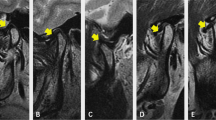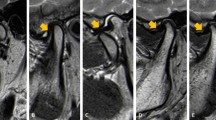Abstract
Purpose
The purpose of this study was to evaluate the relationship between computed tomography (CT) values of the condylar surface and temporomandibular joint (TMJ) disc position in the sagittal plane before and after sagittal split ramus osteotomy (SSRO) setback surgery, retrospectively.
Materials and methods
The subjects were 75 patients (150 condyles) who underwent bilateral SSRO setback surgery. They were divided into two groups (42 symmetric patients and 33 asymmetric patients). Maximum CT values (pixel values) of five points of the condylar surface and condylar height, length, fossa height, fossa length, and ramus angle in the sagittal plane were measured preoperatively and 1 year postoperatively. Disc position was classified as anterior disc displacement, anterior type, fully covered type, and posterior type, both pre- and postoperatively, using magnetic resonance imaging (MRI).
Results
Postoperative value was significantly higher than preoperative one in CT value of 135° (P = 0.0199) and 180° (0.0363), in the non-deviation side in the asymmetry group. The anterior disc displacement group was significantly larger than those of some other areas pre- and postoperatively in the CT value of 0° point (P < 0.05).
Conclusions
This study suggested that CT value of the posterior site of the condylar surface could change in the non-deviation side in the asymmetry group after 1 year SSRO, and the condyle with anterior displacement showed high CT value at the anterior site of the condyle before and after surgery.











Similar content being viewed by others
References
Leonard M (1976) Preventing rotation of the proximal fragment in the sagittal ramus split operation. J Oral Surg 34:942
Harada K, Okada Y, Nagura H, Enomoto S (1996) A new condylar positioning appliance for two-jaw osteotomies (Le Fort I and sagittal split ramus osteotomy). Plast Reconstr Surg 98:363–365
Isberg AM, Isacsson G (1986) Tissue reactions of the temporomandibular joint following retrusive guidance of the mandible. Cranio 4:143–148
Ellis E 3rd, Hinton RJ (1991) Histologic examination of the temporomandibular joint after mandibular advancement with and without rigid fixation: an experimental investigation in adult Macaca mulatta. J Oral Maxillofac Surg 49:1316–1327
Rotskoff KS, Herbosa EG, Villa P (1991) Maintenance of the condyle proximal segment position in orthognathic surgery. J Oral Maxillofac Surg 49:2–7
Gerressen M, Zadeh MD, Stockbrink RD, Ghassemi A (2006) The functional long-term results after bilateral sagittal split osteotomy (BSSO) with and without a condylar position device. J Oral Maxillofac Surg 64:1624–1630
Mongini F (1990) Condylar remodeling after occlusal therapy. J Prosthet Dent 43:568–577
Cassidy DW, Herbosa EG, Rotskoff KS, Johnston LE (1993) A comparison of surgery and orthodontics in “borderline” adults with class II, division 1 malocclusions. Am J Orthod Dentofac Orthop 104:455–470
Susami T, Kuroda T, Yano Y, Nakamura T (1992) Growth changes and orthodontic treatment in a patient with condylolysis. Am J Orthod Dentofac Orthop 102:295–301
Iizuka T, Lindqvist C, Hallikainen D, Mikkonen P, Paukku P (1991) Severe bone resorption and osteoarthrosis after miniplate fixation of high condylar fractures. Oral Surg Oral Med Oral Pathol Oral Radiol 72:400–407
Miller RI, MacDonald DK (1986) Remodeling of bilateral condylar fractures in a child. J Oral Maxillofac Surg 44:1008–1010
Azaz B, Nitzan DW, Brin H (1991) Condylar hyperplasia: remodeling of facial structures following condylectomy. Report of 2 cases. Int J Adult Orthod Orthognath Surg 6:47–55
Eckerdal O, Sund G, Astrand P (1986) Skeletal remodeling in the temporomandibular joint after oblique sliding osteotomy of the mandibular rami. Int J Oral Maxillofac Surg 15:233–239
Lettey S, Seedhom BB, Berry E, Cuppone M (2003) Quality assessment of the cortical bone of the human mandible. Bone 32:35–44
O’Ryan F, Epker B (1984) Temporomandibular joint function and morphology: observations on the spectra of normalcy. Oral Surg Oral Med Oral Pathol Oral Radiol 58:272–279
Ueki K, Yoshizawa K, Moroi A, Iguchi R, Kosaka A, Ikawa H, Saida Y, Hotta A, Tsutsui T (2015) Changes in computed tomography values of mandibular condyle and temporomandibular joint disc position after sagittal split ramus osteotomy. J Craniomaxillofac Surg 43:1208–1217
Ueki K, Nakagawa K, Marukawa K, Takatsuka S, Yamamoto E (2005) The relationship between temporomandibular joint and stress angulation in skeletal class III patients. Eur J Orthod 27:501–506
Ueki K, Nakagawa K, Takatsuka S, Yamamoto E (2006) The change of stress distribution on the condyle after mandibular setback surgery. Eur J Orthod 28:433–439
Ueki K, Nakagawa K, Takatsuka S, Yamamoto E, Laskin DM (2008a) Comparison of the stress direction on the TMJ in patients with class I, II, and III skeletal relationships. Orthod Craniofac Res 11:43–50
Ueki K, Nakagawa K, Takatsuka S, Shimada M, Marukawa K, Takazakura D, Yamamoto E (2000) Temporomandibular joint morphology and disc position in skeletal class III patients. J Craniomaxillofac Surg 28:362–368
Ueki K, Nakagawa K, Takatsuka S, Yamamoto E (2001) Plate fixation after mandibular osteotomy. International J Oral Maxillofac Surg 30:490–496
Ueki K, Degerliyurt K, Hashiba Y, Marukawa K, Nakagawa K, Yamamoto E (2008b) Horizontal changes in the condylar head after sagittal split ramus osteotomy with bent plate fixation. Oral Surg Oral Med Oral Pathol Oral Radiol 106:656–661
Dahlberg G (1940) Statistical methods for medical and biological students. George Allen and Unwin, London, pp 122–132
Kerstens HCJ, Tuinzing DB, Golding RP, Van der Kwast WAM (1990) Condylar atrophy and osteoarthrosis after bimaxillary surgery. Oral Surg Oral Med Oral Pathol 69:274–280
Moore KE, Gooris PJJ, Stoelinga PJW (1991) The contributing role of condylar resorption to skeletal relapse following mandibular advancement surgery. Report of 5 cases. J Oral Maxillofac Surg 49:448–460
Merkx MW, Van Damme PA (1994) Condylar resorption after orthognathic surgery. J Craniomaxillofac Surg 22:53–58
Arnett GW, Milam SB, Gottesman L (1996a) Progressive mandibular retrusion-idiopathic condylar resorption. Part I. Am J Orthod Dentofac Orthop 110:8–15
Arnett GW, Milam SB, Gottesman L (1996b) Progressive mandibular retrusion-idiopathic condylar resorption. Part II. Am J Orthod Dentofac Orthop 110:117–127
Cutbirth M, Van Sickels JE, Thrash WJ (1998) Condylar resorption after bicortical screw fixation of mandibular advancement. J Oral Maxillofac Surg 56:178–182
Hoppenreijs TJM, Freihofer HPM, Stoelinga PJW, Tuinzing DB, van't Hof MA (1998) Condylar remodelling and resorption after Le Fort I and bimaxillary osteotomies in patients with anterior open bite. A clinical and radiological study. Int J Oral Maxillofac Surg 27:81–91
Ueki K, Okabe K, Marukawa K, Mukozawa A, Moroi A, Miyazaki M, Nakagawa K, Yamamoto E (2012a) Effect of self-setting α-tricalcium phosphate between segments for bone healing and hypoaesthesia in lower lip after sagittal split ramus osteotomy. J Craniomaxillofac Surg 40:119–124
Ueki K, Okabe K, Marukawa K, Mukozawa A, Moroi A, Miyazaki M, Sotobori M, Ishihara Y, Yoshizawa K, Ooi K, Kawashiri S (2013) Assessment of bone healing and hypoesthesia in the upper lip after Le Fort I osteotomy with self-setting α-tricalcium phosphate and absorbable plates. J Craniomaxillofac Surg 41:129–134
Ueki K, Takeuchi N, Nakagawa K, Yamamoto E (2009) Simplified stress analysis on the temporomandibular joint in class III patients with and without mandibular asymmetry using a rigid body spring model. Orthod Craniofac Res 12:312–318
Ueki K, Nakagawa K, Marukawa K, Yamamoto E, Takeuchi N (2010) Stress change on the temporomandibular joint in mandibular prognathism subjects with asymmetry after orthognathic surgery. Eur J Orthod 32:522–529
Ueki K, Moroi A, Sotobori M, Ishihara Y, Marukawa K, Yoshizawa K, Kato K, Kawashiri S (2012b) Changes in temporomandibular joint and ramus after sagittal split ramus osteotomy in mandibular prognathism patients with and without asymmetry. J Craniomaxillofac Surg 40:821–827
Cakur B, Bayrakdar IS (2016) No proven correlations between bone quality and degenerative bone changes in the mandibular condyle and articular eminence in temporomandibular joint dysfunction. Oral Radiol 32:33–39
Ueki K, Marukawa K, Shimada M, Hashiba Y, Nakgawa K, Yamamoto E (2007) Condylar and disc positions after sagittal split ramus osteotomy with and without Le Fort I osteotomy. Oral Surg Oral Med Oral Pathol Oral Radiol Endod 103:342–348
Author information
Authors and Affiliations
Corresponding author
Ethics declarations
This study followed the Declaration of Helsinki on medical protocol and ethics and the regional Ethical Review Board of the University of Yamanashi approved the study.
Conflict of interest
The authors declare that they have no conflict of interest.
Funding
This study has no funding source.
Informed consent
All patients gave informed consent prior to the examination.
Rights and permissions
About this article
Cite this article
Ueki, K., Yoshizawa, K., Moroi, A. et al. Condylar surface CT value in sagittal plane before and after sagittal split ramus osteotomy. Oral Maxillofac Surg 21, 159–169 (2017). https://doi.org/10.1007/s10006-017-0612-7
Received:
Accepted:
Published:
Issue Date:
DOI: https://doi.org/10.1007/s10006-017-0612-7




